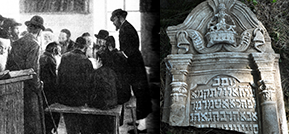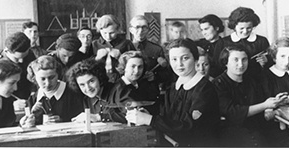The exact beginning of the settlement of Jews in Bohorodchany is unknown, but documentary data about the Jewish community exists from the early eighteenth century. In 1717, the Jews of Bohorodczany and the adjacent villages paid a head tax of 756 gold coins (Pinkas Hakehilot, 71).
The Polish census of 1764 gives more detailed information on the Jewish population of Bohorodchany (Stampfer, 122-3). The community (kahal) included 646 Jews of both genders and 26 infants under the age of one year. 543 Jews with 21 infants lived in the town of Bohorodchany itself, and the remaining 103 were dispersed throughout the surrounding villages according to the following breakdown:
Sadzawka - 8
Stare Bohorodczany - 6
Głębokie - 8
Zwiniacz - 6
Chmielówka - 2
Rosólna - 25 (and two infants)
Kosmacz - 6
Grabowiec - 7
Pochówka - 5
Roholina Górna - 8 (and two infants)
Roholina Dolna - 11
Lachowce - 11 (and one infant)
The Bohorodchany community with 646 Jews was the ninth in size among 18 communities in the Kołomyia district (powiat). While the four biggest communities included slightly more than a thousand Jews each (Nadworna - 1,196, Śniatyn - 1,123, Kołomyia - 1,059, Kuty - 1,013), and two others slightly less than a thousand Jews (Horodenka - 956, Zabłatow - 946), the Bohorodchany and Gwozdzia (659) communities were considered medium sized communities. All other communities included less than 500 Jews (Stampfer, 120-5).
In 1756, there were 314 houses with 1,134 residents in the town (Istoriia Bohorodchaniv, 82).
 In 1785 a school for Jews that was part of the Hertz Homberg educational network was established in Bohorodchany. However, it closed after several years (Pinkas Hakehilot, 71). In 1789, a German school was opened in Bohorodchany, but it is unlikely that any Jews studied there (Istoriia Bohorodchaniv, 82).
In 1785 a school for Jews that was part of the Hertz Homberg educational network was established in Bohorodchany. However, it closed after several years (Pinkas Hakehilot, 71). In 1789, a German school was opened in Bohorodchany, but it is unlikely that any Jews studied there (Istoriia Bohorodchaniv, 82).
See: Bohorodczany (Brotchin) - Jews in the 19th and early 20th centuries






